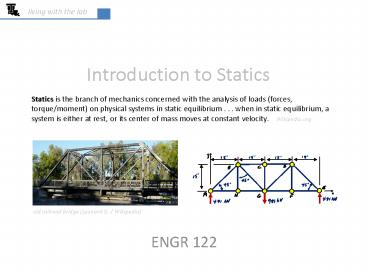Introduction to Statics PowerPoint PPT Presentation
Title: Introduction to Statics
1
Introduction to Statics
living with the lab
Statics is the branch of mechanics concerned with
the analysis of loads (forces, torque/moment) on
physical systems in static equilibrium . . . when
in static equilibrium, a system is either at
rest, or its center of mass moves at constant
velocity. Wikipedia.org
old railroad bridge (Leonard G. / Wikipedia)
- ENGR 122
2
living with the lab
Units of Measure
Most units of measure can be broken down into the
basic units of length (L), mass (M) and time (t).
physical quantity dimension SI system U.S. Customary system
length
area
volume
3
living with the lab
Units of Measure
physical quantity dimension SI system U.S. Customary system
L length M mass ttime
4
living with the lab
Three Characteristics of a Force
- Magnitude (F)
- how hard you are pushing or pulling
- graphically represented by the length of the arrow
- Direction (q)
- usually defined by an angle measured relative to
a coordinate system
5
living with the lab
Components of a Force
Forces can be split into components that align
with a coordinate system. The force is the vector
sum of the components.
y
q
x
defined relative to the x axis in this case
6
living with the lab
Resultants
How can we find the net effect of two or more
forces that act on a body?
Geometric Solution If all applied forces are
arranged head to tail, a vector drawn from the
tail of the first vector to the head of the last
vector represents the resultant of all the forces.
7
living with the lab
Class Problem Two ants are hitched to a beetle
and pull with the forces shown
- Find the x and y components of the force exerted
by ant 1. - Find the x and y components of the force exerted
by ant 2. - Find the x component of the resultant force of
the ants. - Find the y component of the resultant force of
the ants. - Find the resultant force of the ants.
- What angle does the resultant force make
- with the x-axis?
PowerShow.com is a leading presentation sharing website. It has millions of presentations already uploaded and available with 1,000s more being uploaded by its users every day. Whatever your area of interest, here you’ll be able to find and view presentations you’ll love and possibly download. And, best of all, it is completely free and easy to use.
You might even have a presentation you’d like to share with others. If so, just upload it to PowerShow.com. We’ll convert it to an HTML5 slideshow that includes all the media types you’ve already added: audio, video, music, pictures, animations and transition effects. Then you can share it with your target audience as well as PowerShow.com’s millions of monthly visitors. And, again, it’s all free.
About the Developers
PowerShow.com is brought to you by CrystalGraphics, the award-winning developer and market-leading publisher of rich-media enhancement products for presentations. Our product offerings include millions of PowerPoint templates, diagrams, animated 3D characters and more.

